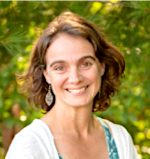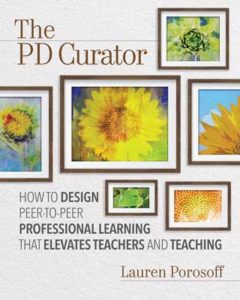Curating PD to Elevate Teachers and Teaching
The PD Curator: How to Design Peer-to-Peer Professional Learning That Elevates Teachers and Teaching
By Lauren Porosoff
(ASCD, 2021 – Learn more)
Reviewed by Jeny Randall

Porosoff notes that “as a PD curator, you’re not just giving teachers an exciting menu of options to choose from or even weeding out the boring and pointless ones. You’re caring for the professionals and for the profession.” (p. xv)

While this book is written for school leaders, teachers will appreciate the dedication to scheduling professional learning during existing meetings to make the best use of their time:
“If we want teachers to engage fully in peer-to-peer PD and get more out of it, then we might consider how we structure their day-to-day physical, temporal, and social contexts to orient them toward learning from and with one another.” (p. 7)
Porosoff’s suggestions set me to thinking about my own staff meetings – surely dedicating one meeting a month to professional learning would be worthwhile.
Stand-out Chapters
The PD Curator is well-written. Porosoff’s narrative examples and scenarios both engage the reader and offer specific insight into the opportunities and challenges faced by offering PD in-house.
I found Chapter Two “Making It Inclusive: Preparing for Professional Learning” especially exciting because of the easy-to-use tools that create a culture of peer-to-peer learning and help educators reflect on their role as experts. I came to the book thinking it would help me lead more engaging PD for my teaching team, and in this chapter, I saw how I could discover and showcase the expertise that our teachers bring in addition to my own offerings.
Chapter Three “Making It Participatory: Structuring Professional Learning” offers six formats and the related planning tools for structuring PD. Specific instructions make implementing these formats easy. The chapter includes a discussion on how to craft a “learner-centered workshop” (p.41) that uses teachers’ time well. The strategies Porosoff offers are familiar; the best PD I’ve participated in allows me to experience or use the content I’m learning.
Further chapters explore crafting PD units to continue the momentum and assessing PD to ensure it meets the needs of the participants.
Creating a culture of equitable learning
Throughout the book, Porosoff is mindful of equity and promotes the involvement of all teachers. She encourages school leaders to “expand the definitions of good teaching to include those who have been marginalized within the field of professional learning” (p. 13).
In addition, Porosoff is attentive to the positions of power and vulnerability that peer-to-peer learning can create both in those seen as “experts” and in those who may ask for help. She offers thoughtful and practical tips for how to level the playing field so that all teachers can participate in a way they feel comfortable.
Porosoff provides school leaders the opportunity to reflect on their current practices, assumptions, and professional learning. For example, figure 6.1 (p.110) allows curators to consider how meeting time is used, and the final chapter explores aligning PD curation with leadership values (and considering which values lie at the heart of your work).
Beyond reading
The PD Curator offers strategies for crafting professional learning and guides school leaders in creating a culture of learning, which is well worthwhile on its own. However, professional development is big business for a reason. School leaders might need to consider what opportunities exist for teachers to earn credit for ongoing in-house PD, or how peer-to-peer learning can work in conjunction with entities who can offer credit.
For example, in Vermont, participating as a mentor/mentee is an acceptable form of PD for licensure. While it may add an interesting layer to the dynamic, something like Porosoff’s “Intervisits” strategy, in which a group of teachers visit each others’ rooms and offer each other feedback, could fit within this format. In New York State, however, those offering continuing ed (CTLE) must be accredited by the state.
I look forward to implementing the ideas in this book both to provide professional learning for my teaching team and to develop my own skills as a teacher-leader. Not only do I recommend this book, but I would seek out professional development led by the author.
Jeny Randall is the Middle School Director and LA teacher at Saratoga Independent School in New York State. She also oversees the curriculum and program development for grades 6 – 8. Jeny is a Responsive Classroom certified teacher. Outside of school, Jeny teaches yoga, reads whatever students send her way, and spends time with her family, outside if possible.



































